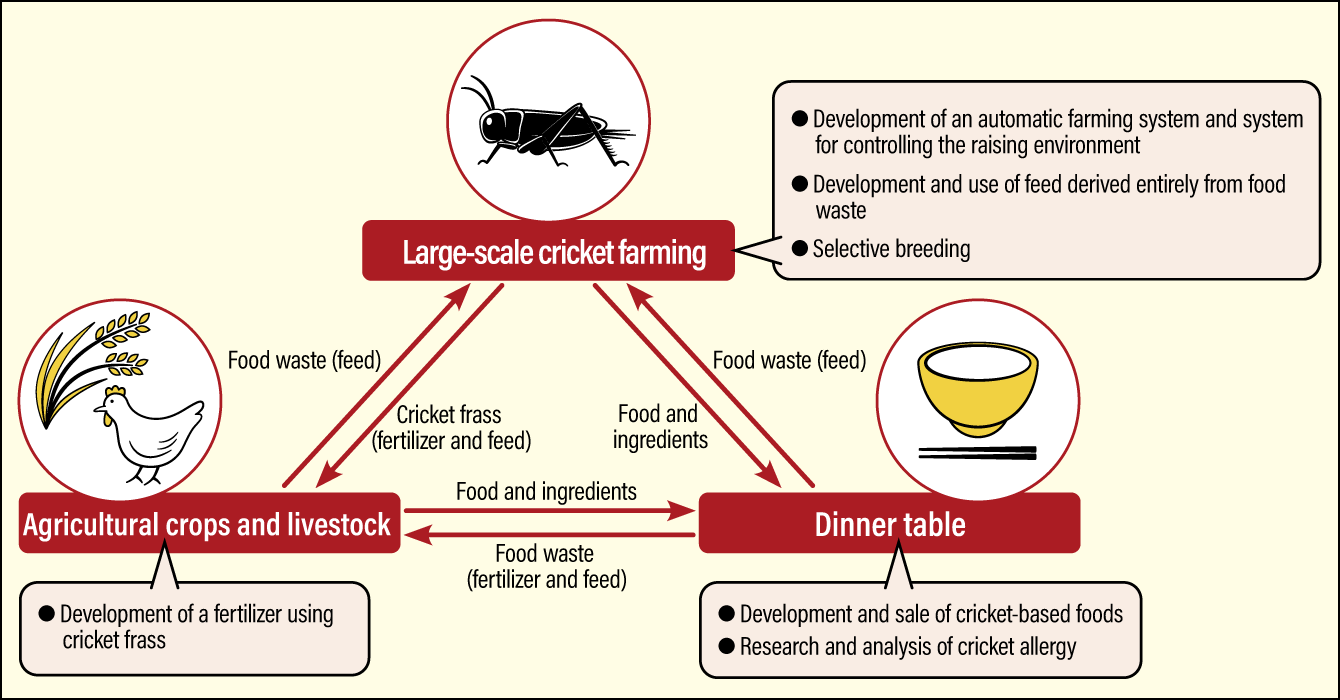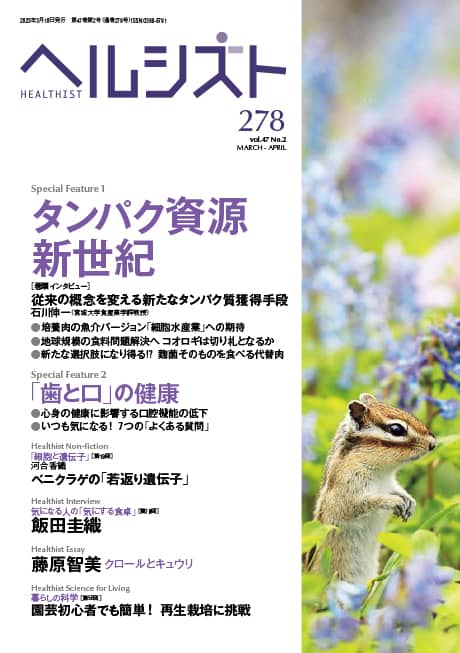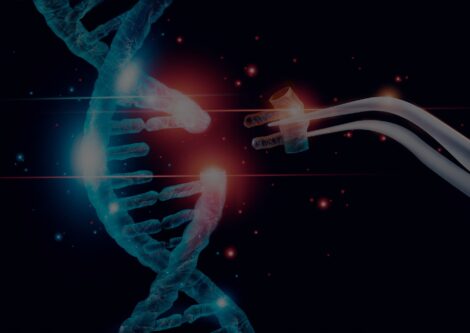News that insects are coming under the spotlight as a new source of protein does, to be honest, make one feel rather aghast at the thought of eating bugs. However, once upon a time, Japanese people actually consumed insects as a valuable source of animal protein, as illustrated by the fact that the culture of eating creatures such as grasshoppers, silkworms, and the larvae of assorted species of aquatic insects referred to collectively as zazamushi still survives today in the Nanshin region of Nagano Prefecture, for example. Crickets are the most suitable insect for eating. Boasting a flavor described as resembling an aromatic shrimp, crickets are highly nutritious, with a protein content to rival meat. Could crickets play a part in solving food problems?
Special Feature 1 – The New Era of Protein Resources Toward a solution to global food problems:
Will crickets be the trump card?
composition by Yumi Ohuchi
illustration by Rokuhisa Chino
While various types of insects have been consumed in every corner of the world since ancient times, as demonstrated by the fact that even some regions of Japan have a custom of eating grasshoppers, one cannot really say they are a major food, generally speaking. However, since the Food and Agriculture Organization of the United Nations (FAO) published the Edible insects report in 2013, looking at the role of insects in food and animal feed, the use of insects as a new source of protein has been garnering attention. Crickets are the most suitable insect for eating.
The laboratory to which I belong has been using crickets for many years as a model organism in developmental biology researchfocused on how organisms take shape from fertilized eggs. It was in 2016 that I began my research into edible crickets, motivated by the desire to use the results of research to date and cricket farming techniques to benefit society. At the time, there were no research institutes in Japan conducting research into edible crickets on an extensive scale, so many of those around me thought I had lost my mind.
AKA land shrimp
Developing something for use as food means you have to commercialize it and get society to recognize its value. Initially, we sought companies that would cooperate with us so that we could develop crickets as a commercial product through academic-industrial collaboration. However, whereas foodstuffs made with crickets were already being sold in North American and European markets, there were no precedents for the commercialization of such products in Japan, and we were unable to find any companies with a positive attitude toward developing a business in this area after three years of trying. That was when we decided to do it ourselves and established Gryllus as a university startup in 2019.
To solve the diverse array of critical food problems such as food loss and the environmental impact of food production, we believe it is necessary to position crickets as circular food, rather than as merely an insect-based food, and to build a sustainable circular food production system. We are working to achieve this via a two-pronged approach of conducting research and undertaking business aimed at the social implementation of the outcomes of our research.
First and foremost, flavor and nutrients are crucial in developing a food product. As crickets are rich in umami, with a flavor reminiscent of aromatic shrimp, they are also known as “land shrimp.” Their protein content per 100 g is comparable to that of meat, and they contain various nutrients needed by the body, including zinc, iron, calcium, magnesium, vitamins, and omega-3 unsaturated fatty acids (Table). They are also high in chitin and other dietary fiber, and research overseas found that levels of the probiotic Bifidobacterium animalis increased and the intestinal environment improved when healthy adults consumed cricket flour.
| Nutritional information for Gryllus dried crickets (per 100 g) | |
| Water content | 9.3g |
| Protein | 61.4g |
| Fat | 19.2g |
| Ash content | 4.6g |
| Carbohydrates | 0.5g |
| Dietary fiber | 5.0g |
From the perspective of production efficiency, crickets have the advantage of being easier to raise than other insects and also grow faster, reaching the imago (adult) stage in around 35 days. This is also the reason why crickets have been used as experimental models in biology research. In addition, in terms of size, they belong to the large insects, so it is expected that a lot of nutrients can be obtained from them.
Also crucial to their position as a sustainable circular food is the fact that they have a low environmental impact and require few resources. The quantity of feed and water required to produce protein from crickets is far lower than in the case of other food producing animals; data has been presented to show that the conversion rate from cricket feed to protein is highly efficient, with a rate double that of chickens, four times that of pigs, and 12 times that of cattle. This is thought to be due to the fact that insects are poikilothermic and therefore do not require energy to maintain their body temperature, unlike mammals and birds, which are homeothermic (have bodies equipped with a heat regulating mechanism). Emissions of the greenhouse gas CO2 from livestock are a problem at present; as insects emit very little gas by weight compared with other food producing animals, it would be fair to say that they are an environmentally friendly source of protein.
Another important feature is the fact that crickets are omnivorous. Insects generally have strong food preferences, as demonstrated by the fact that grasshoppers eat only gramineous plants and silkworms only mulberry leaves; there are few omnivorous insects. This is to preserve an adequate habitat for the species, and producing insects that have feeding preferences also necessitates the cultivation of their feed. However, omnivorous crickets can be fed on food waste.
Thus, crickets have a number of advantages, as outlined above. Incidentally, the word “cricket” actually covers a variety of species. The species we have maintained for research purposes is the white-eyed mutant strain of the cricket Gryllus bimaculatus, whose scientific name provided the inspiration for the name of our company (Figure 1). The imagoes are blackish-brown and about 3-4 cm long, with two white spots on its wing joints, hence the “bimaculatus” element of its name, which means “two-spotted” in Latin. Acheta domesticus is another cricket species cultivated for food purposes, but Gryllus bimaculatus is somewhat larger and therefore thought to be better from a nutritional perspective. While crickets are cannibalistic, Gryllus bimaculatus is less aggressive and, as such, has the advantage of being easy to cultivate. We are using Gryllus bimaculatus in both our research and our efforts to develop an edible cricket industry.

Figure 1. Gryllus bimaculatus (white-eyed mutant strain)Gryllus bimaculatus have been kept at Tokushima University for research purposes for about 30 years. This naturally occurring white-eyed strain has a recessive gene.
Products made from powdered dried crickets
In the circular food production system we aim to establish, we will raise crickets fed on food waste; those crickets will then become food, while cricket frass (manure) will be used as fertilizer for crops and feed for livestock that will in turn become food for humans. Leftovers from that food will return to the cycle in the form of cricket feed (Figure 2).

Figure 2. The circular food production systemThis concept involves using food waste generated by society to produce new food, thereby creating a sustainable circular food cycle centered on crickets, which have a low impact on resources and the environment.
This cycle will not keep going unless we can popularize crickets as an everyday food and ingredient in food. However, many people are reluctant to try foods for the first time. The hurdle is even higher when that food is an insect. Accordingly, we have developed and brought to market confectionery and other food products to which cricket flour made from dried crickets has been added, in an effort to dispel people’s psychological resistance to eating crickets, while capitalizing on their umami (Figure 3). The rice crackers and other snacks have met with a positive reception, but they are still no more than the first step. This is because crickets could become an everyday foodstuff once the culture of cooking them for ourselves becomes established. While it is also possible to buy cricket flour and extract that one can add to ingredients oneself, we want to make cricket-based foods more prevalent in stages, ultimately aiming for a world in which dishes made from frozen or fresh crickets routinely feature on people’s dinner tables.

Figure 3. Cricket-based foodsAt the current stage, cricket flour is being added to confectionery and other foods, so that people can readily enjoy the flavor of crickets without any feelings of reluctance. There are also many products created in collaboration with manufacturing retailers.
Making feed from food waste alone
Also important is the production base, in the form of systems enabling a large number of crickets to be raised and harvested efficiently, while delivering stable levels of quality in the process. Crickets basically like dark, cramped spaces, so we raise them in little shelters with spaces for food and water. While they are easy to raise, crickets need to be kept fed and watered, and their molted shells and frass have to be collected, which entails labor and expense. Consequently, while development of an automatic farming system is underway, we are currently striving to make cricket raising more efficient and less costly, leveraging the results of our experiments in raising crickets to date in order to devise raising and harvesting methods that offer a high survival rate with minimal effort (Figure 4). In addition, research into appropriate control of temperature, light, humidity, and other environmental factors is also progressing.

Figure 4. Cricket-farming centerA system allowing for the efficient reproduction, raising, and harvesting of crickets is being developed, taking up the whole of a disused elementary school building. Local residents are being employed there part-time, thereby helping to revitalize local employment.
The key to developing the circular food production system will be producing cricket feed from food waste alone. While crickets are omnivorous, they do have food preferences, nevertheless. And there is no point giving them feed that does not promote their growth, no matter how much they eat. Producing cricket feed that promotes efficient, healthy growth from food waste alone was a nigh-on impossible task. As a result of numerous experiments, we succeeded in developing a feed derived entirely from food waste by combining several different types of waste in a wheat bran base, rather than using a single form of food waste alone. However, this is not the goal. At present, we are using residues generated in the processing of agricultural crops, but food waste is generated from all kinds of sources. Tireless research will be required if we are to continue using a diverse array of food waste.
Furthermore, the cycle will only be established when cricket frass is used in fertilizer and animal feed. With the cooperation of a farmer, we are currently conducting experiments on a single patch of agricultural land. If the crickets’ feed changes, their frass also changes, so we constantly have to analyze their droppings. Just as with food products, producers tend to be reluctant to use something unprecedented. I believe we need to demonstrate the effectiveness and safety of cricket frass as a fertilizer, so that producers can use it with peace of mind.
At present, the crickets being produced for food use —— including our products —— are wild species. However, among ourexisting varieties of livestock and agricultural crops are many that are the result of selective breeding for flavor or production efficiency. Selective breeding will also be required to make crickets more suitable for food use. Today, genome editing technology can be used to achieve selective breeding at a faster pace than has conventionally been the case.
We already have cricket genome editing technology that we have cultivated through our developmental biology research, so we have embarked on a study that applies this technology to selective breeding. The first stage of our research involves removing elements that are negative from a food use perspective. One challenge is that of making crickets paler in color. This is because the foods to which cricket flour can be added are limited, due to the visual impression given by the dark brown color of the crickets’ bodies.
We are currently analyzing genes relating to body color and the pigment synthesis pathways. Once these become clear, we will be able to produce white or yellow crickets by using genome editing technology to alter specific genes.
Another issue is the fact that crickets contain tropomyosin, which is the cause of shrimp and crab allergies. Accordingly, some people’s constitution may put them at risk of an allergic reaction. Tropomyosin is a protein essential to survival and we know from existing research which gene regions are involved in the onset of the allergy. In other words, it is theoretically possible to remove allergens through genome editing. The ultimate goal is to make crickets allergy-free, but we think the most pressing issue is to shed light on the reality by ascertaining the incidence rate of cricket allergy and the harms that such an allergy might cause to people’s health. The number of companies now developing and selling cricket-based foods is on the rise, so this is a problem on which the whole industry should work.
Developing a circular food production system using insects
The next stage will be selective breeding to increase production efficiency. For example, this will include breeding crickets that do not engage in cannibalism, and which grow bigger more quickly. We are also eyeing the possibility of adding functions to crickets as the final stage. One can already buy tomatoes modified using genome editing technology to be richer in gamma-aminobutyric acid (GABA), which is effective in curbing hypertension. We believe that it would be possible to add ingredients beneficial to the human body to crickets in the same way.
The government has also focused its attention on such possibilities and advantages of edible crickets. Already underway is a project entitled “Insect-Based Sustainable Food Production Systems toward Global Food Security and Human Space Exploration,” which focuses on crickets and black soldier flies and is being undertaken as part of the Cabinet Office’s Moonshot Agriculture, Forestry and Fisheries Research and Development Program. This project involves 10 research institutes, with participants including Gryllus and Tokushima University, where our laboratory is located. As well as tapping into our research and achievements to date, we are working on the development of new technology based on an interdisciplinary approach, in collaboration with other fields of research.
The ultimate goal of this project is to make it possible to build insect-based circular food production systems not only on Earth, but also in outer space and other extreme environments. There are constraints on the resources that can be used as feed in outer space and the organisms that can be raised there. For example, if we could cultivate crops in a hybrid factory using sunlight and raise crickets fed on the residues left over from their cultivation, we would be able to obtain vitamins and carbohydrates from vegetables and protein from crickets. This would make it possible to establish in outer space a fully circular food production system that would support food and health for humankind. We have also established as our mission the creation of cricket varieties resistant to extreme environments, such as zero-gravity, cosmic radiation, and low-oxygen conditions.
Of course, the global food crisis cannot be solved with crickets alone. It is vital to address the issue through multiple approaches, involving other alternative sources of protein as well. Moreover, there are still many challenges to be overcome in order to make crickets the basis of a circular food production system. A lot of people think the feed must be free of charge, since it is made from food waste, but it actually costs more to recycle than to dispose of it. Nevertheless, someone has to try to put this system into practice.
When I started out on my research into edible crickets, what spurred me on was the question of who would do it if not us, with our extensive knowledge of crickets. I still feel the same way today. And I believe that, if it involves crickets, we can bring our vision to fruition.




















